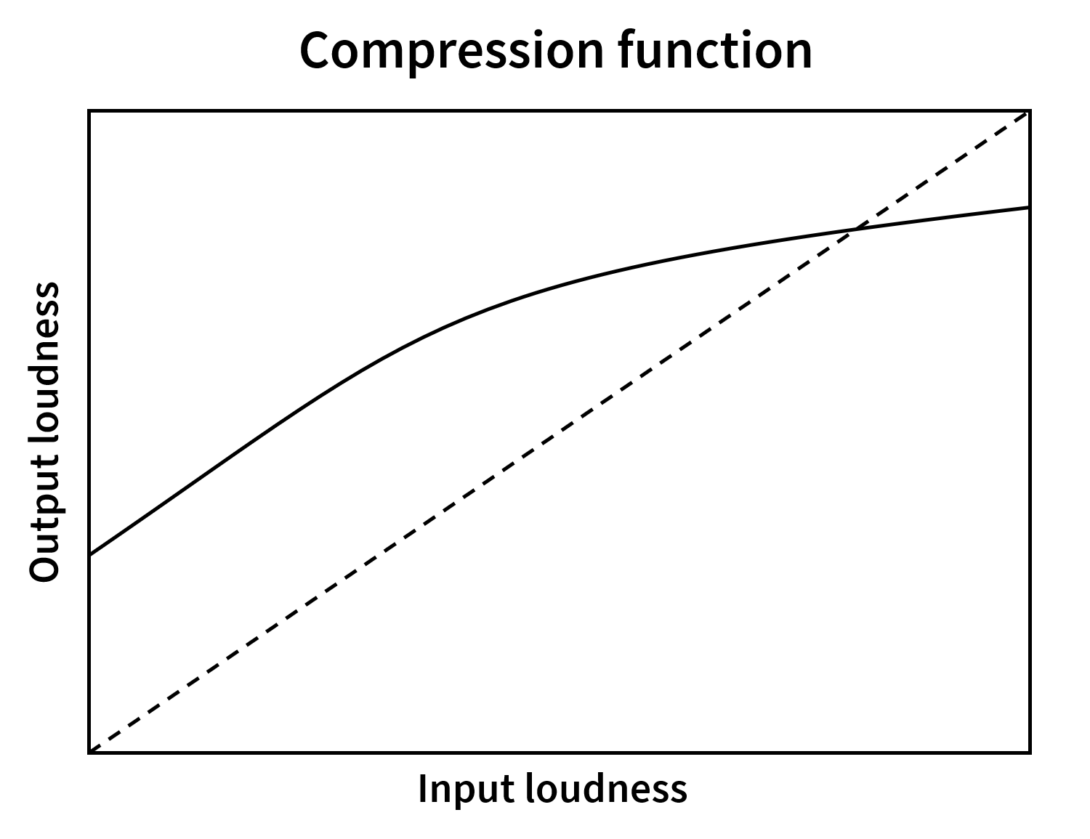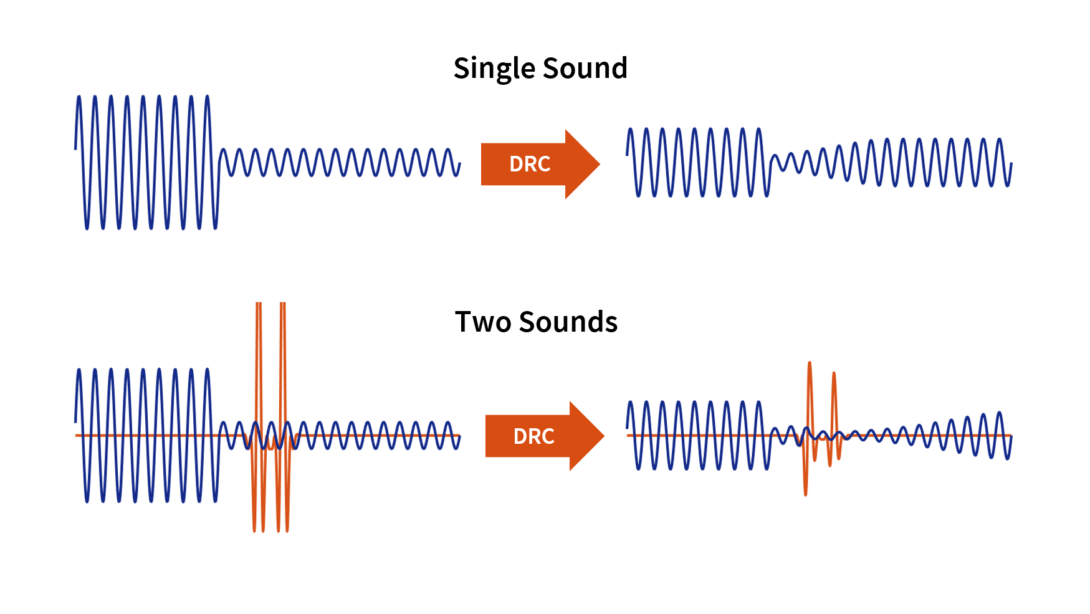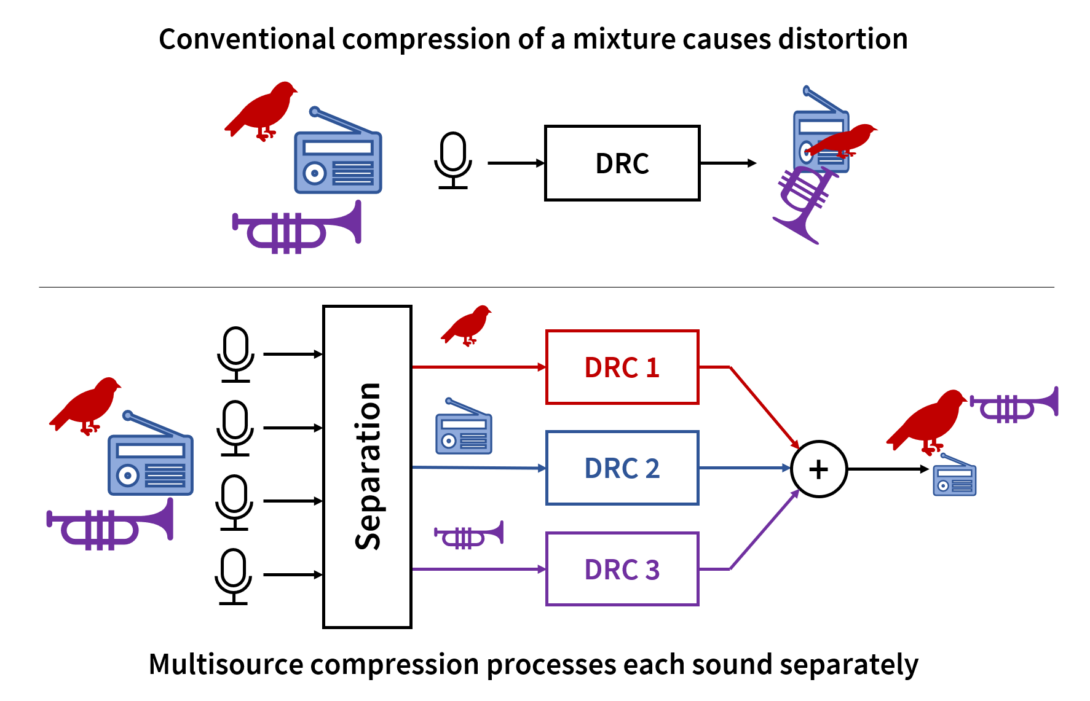Dynamic Range Compression and Noise
This post accompanies our presentation “Dynamic Range Compression of Sound Mixtures” at the 2020 Acoustical Society of America meeting and our paper "Modeling the effects of dynamic range compression on signals in noise" in the Journal of the Acoustical Society of America (PDF).
Dynamic Range Compression of Sound Mixtures
Intro

Nearly every modern hearing aid uses an algorithm called dynamic range compression (DRC), which automatically adjusts the amplification of the hearing aid to make quiet sounds louder and loud sounds quieter. Although compression is one of the most important features of hearing aids, it might also be one of the reasons that they work so poorly in noisy environments. Hearing researchers have long known that when DRC is applied to multiple sounds at once, it can cause distortion and make background noise worse. Our research team is applying signal processing theory to understand why compression works poorly in noise and exploring new strategies for controlling loudness in noisy environments.
What is dynamic range compression?

Dynamic range is the difference in level between the loudest and quietest sounds that a person hears. People with hearing loss have reduced dynamic range compared to people with normal hearing; they need amplification to hear quiet sounds, but their ears can pick up loud sounds on their own. If a hearing aid amplified every sound by the same amount, sounds that were already loud could become painful. To make sure that quiet sounds like soft speech are amplified enough to understand but loud sounds like car horns are not painful or dangerous, hearing aids adjust their amplification based on sound level. When sounds are quiet the gain goes up, and when sounds are loud the gain goes down. The dynamic range of the hearing aid output is therefore smaller than the dynamic range of the sounds coming into the microphone.
The amount of gain applied by DRC algorithm is determined by a compression curve. The flatter the curve, the more the dynamic range of the sound is reduced. For example, a hearing aid might use a 3:1 compression ratio, meaning that the level of output goes up by 1 dB for every 3 dB increase in the level of the input signal. Most modern hearing aids use so-called wide dynamic range compression (WDRC), meaning that they compress a wide range of sound levels rather than just limiting loud sounds like the compressors used in music production. The shape of the curve is programmed by the hearing aid manufacturer or audiologist and might be different for different users or listening modes. The audiologist might also adjust how quickly the hearing aids respond to changes in loudness. Typically, a hearing aid will turn gain down within just a few milliseconds of a loud sound, but will increase gain more gradually as the sounds become quieter.
Dynamic range compression and noise

Because DRC is a nonlinear algorithm — it processes the signal differently depending on the signal’s level — it can cause distortion when used on multiple sounds at once. Nonlinear distortion from DRC sounds cool in Daft Punk songs, but it’s less welcome for a hearing aid user trying to have a conversation in a crowded restaurant. Noisy environments with multiple sound sources are some of the most difficult for people with hearing loss, but hearing aids rarely help in loud noise. In fact, they can sometimes make things worse. There is evidence that DRC is part of the problem.
Compression causes distortion because it applies the same processing to multiple sounds in a mixture. Suppose that a hearing aid user is holding a quiet conversation and a door slams in the background. To protect the listener from the sudden loud sound, the hearing aids will quickly turn down their gain. But the same amplification is applied to every sound going through the hearing aid, so the talker’s voice will also get quieter. If there are many such background sounds, the gain will fluctuate, causing distortion to the sound the listener wants to hear.
Compression can also make noise worse. A common complaint from hearing aid users is that the devices seem to amplify background noise. Many hearing aids do include noise reduction algorithms designed to block low-level noise like air conditioners and preserve high-level sounds like speech. But DRC algorithms have the opposite effect: They amplify quiet sounds, including sounds a listener might not want to hear. High-end hearing aids try to compensate for this effect by detecting whether the user is listening to speech or noise and switching between processing settings, but that approach does not work well when there is both speech and noise at the same time.
Hearing scientists have known about these problems for decades and have documented them in laboratory experiments with real hearing aids. Studies with people with hearing loss have shown that DRC can improve the listening experience in quiet environments, but distortion can make it harder to understand speech in noise. However, the problem has not received much attention from mathematicians or engineers. Signal processing research methods can help us to understand why compression works poorly in noise and develop new approaches.
Recently, we have developed a mathematical model for the effects of DRC on mixtures of multiple sounds. By making some simplifying assumptions about the signals, we can quantify the effect that a DRC system has on each individual sound and analyze how the sounds in the mixture affect each other. Using this framework, we can prove theorems that explain three effects that hearing researchers have documented experimentally:
- When compression is applied to multiple sounds at once, the signals distort each other and become negatively correlated, meaning that as one gets louder the other gets quieter and vice versa.
- When multiple sounds are compressed together, their dynamic ranges are not reduced by as much as they would have been alone, meaning that noise makes compression less effective. This effect is strongest when the noise is louder than the signal of interest.
- When a dynamic signal like speech is mixed with steady background noise, compression always makes the signal-to-noise ratio worse. This effect is strongest when the signal of interest is louder than the noise.
All three results follow from the fact that the function relating input sound level to output sound level is concave. That means that any system in which the output loudness increases more slowly than the input loudness – that is, any system that compresses dynamic range – is vulnerable to these distortion effects. The severity of the distortion depends on the strength of compression and on properties of the signals.
Reimagining dynamic range compression

Based on our analysis, distortion is inevitable when we apply compression to more than one sound. To make nonlinear algorithms work better in noisy environments, we need to change how hearing aids deal with multiple sounds. Today’s small, low-power hearing aids perform compression on all sounds together, perhaps with some noise reduction processing before or after the compression step. More powerful devices using many microphones, like the listening systems we are studying in the Illinois Augmented Listening Laboratory, could perform more sophisticated nonlinear processing that reduces dynamic range without introducing distortion or amplifying unwanted noise.
One approach would be to apply separate DRC processing to each sound source. Mixing artists do the same thing when producing music, selecting different compression settings for different instruments or vocals and then combining the processed sounds. In a 2017 paper, we proposed a system that uses microphone array beamforming to apply compression separately to sounds arriving from different directions. Even with only a few extra microphones and imperfect separation, the system produced sound with less distortion and a better signal-to-noise ratio compared to conventional compression. With larger wearable devices, remote microphones, and improved algorithms, multisource compression could perform even better.
Early hearing aids used analog circuits to track signal levels over time and vary the gain of an amplifier; today, most digital DRC algorithms try to imitate these analog systems. But with modern digital signal processing capabilities, we need not limit ourselves to conventional compression algorithms to control dynamic range. There is an opportunity for signal processing researchers to propose creative, ambitious new strategies for hearing aid signal processing in noisy environments. But we will need help from hearing scientists to understand how people hear in complex listening environments: What kind of dynamic range do different types of sound need to have in different levels of background noise? Is it better to compress sounds separately, together, or both? And how do we measure how well our algorithms are working?
Our team plans to continue studying dynamic range compression. We hope that with the help of mathematical models, we can find new approaches to controlling dynamic range in complex sound mixtures. By improving DRC, we can make hearing aids work better in the noisy environments where people with hearing loss need help most.